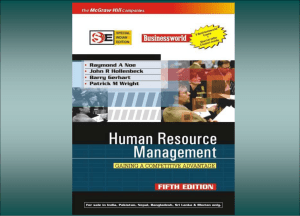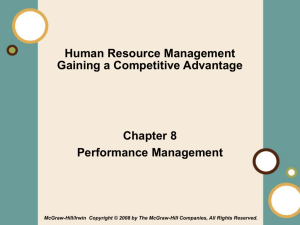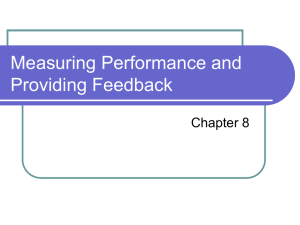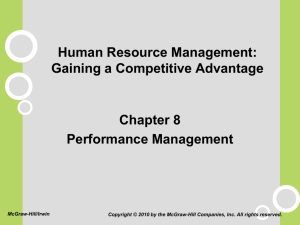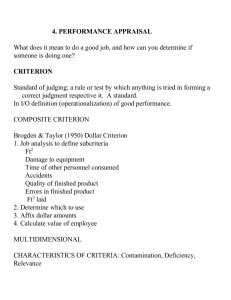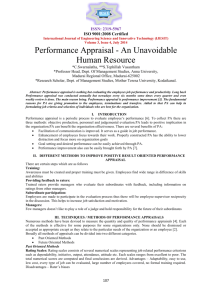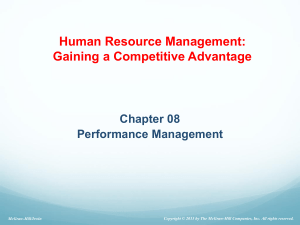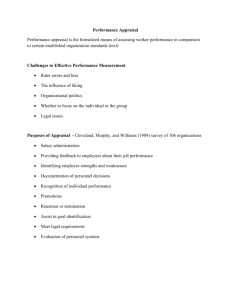Chapter 7 - Implementing a Performance Management System
advertisement
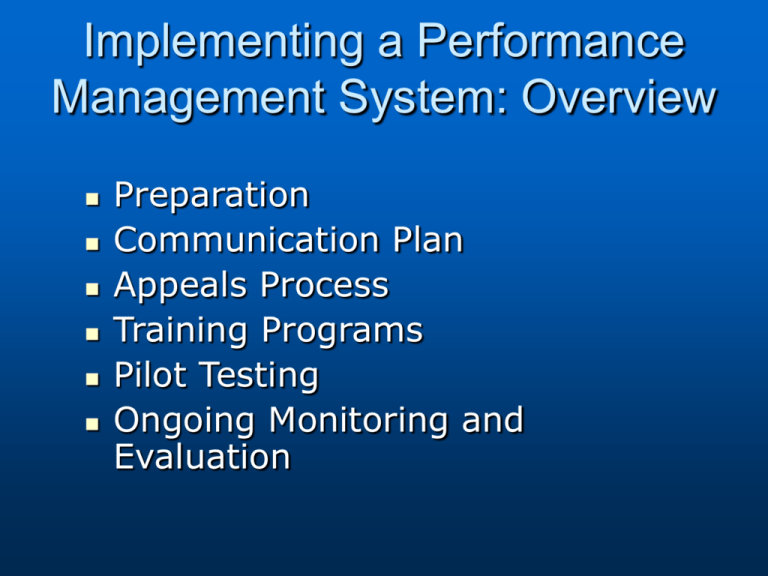
Implementing a Performance Management System: Overview Preparation Communication Plan Appeals Process Training Programs Pilot Testing Ongoing Monitoring and Evaluation Preparation Need to gain system buyin through: • Communication plan regarding Performance Management system Including appeals process • Training programs for raters • Pilot testing system Ongoing monitoring and evaluation Communication Plan answers: What is Performance Management (PM)? How does PM fit in our strategy? What’s in it for me? How does it work? What are our roles and responsibilities? How does PM relate to other initiatives? Cognitive Biases that affect communications effectiveness Selective exposure Selective perception Selective retention To minimize effects of cognitive biases: A. Consider employees: Involve employees in system design Show how employee needs are met To minimize effects of cognitive biases (continued): B. Emphasize the positive Use credible communicators Strike first – create positive attitude Provide facts and conclusions To minimize effects of cognitive biases (continued): C. Repeat, document, be consistent Put it in writing Use multiple channels of communication Say it, and then – say it again Appeals Process Promote Employee buy-in to PM system • Amicable/Non-retaliatory • Resolution of disagreements Appeals Process Employees can question two types of issues: • Judgmental (validity of evaluation) • Administrative (whether policies and procedures were followed) Appeals Process Level 1 • HR reviews facts, policies, procedures • HR reports to supervisor/employee • HR attempts to negotiate settlement Level 2 • Arbitrator (panel of peers and managers) and/or • High-level manager – final decision Rater Training Programs Content Areas to include • Information • Identifying, Observing, Recording, Evaluating • How to Interact with Employees Choices of Training Programs to implement • Rater Error Training • Frame of Reference Training • Behavioral Observation • Self-leadership Training Content A. Information - how the system works • Reasons for implementing the performance management system • Information the appraisal form system mechanics Content (continued) B. Identifying, observing, recording, and evaluating performance • How to identify and rank job activities • How to observe, record, and measure performance • How to minimize rating errors Content (continued) C. How to interact with employees when they receive performance information • How to conduct an appraisal interview • How to train, counsel, and coach Choices of Training Programs Rater Error Training (RET) Frame of Reference Training (FOR) Behavioral Observation Training (BO) Self-leadership Training (SL) Rater Error Training (RET) Goals of Rater Error Training (RET) • Make raters aware of types of rating errors • Help raters minimize errors • Increase rating accuracy Intentional rating errors Leniency (inflation) Severity (deflation) Central tendency Unintentional rating errors Similar to Me Halo Primacy First Impression Contrast Stereotype Negativity Recency Spillover Attribution Possible Solutions for Types of Rating Errors Intentional • Focus on motivation • Demonstrate benefits of providing accurate ratings Unintentional • Alert raters to different errors and their causes Frame of Reference Training (FOR) Goal of FOR* • Raters develop common frame of reference Observing performance Evaluating performance *Most appropriate when PM appraisal system focuses on behaviors Expected Results of FOR Raters provide consistent, more accurate ratings Raters help employees design effective development plans Behavioral Observation Training (BO) Goals of BO • Minimize unintentional rating errors • Improve rater skills by focusing on how raters: Observe performance Store information about performance Recall information about performance Use information about performance Self-leadership Training (SL) Goals of SL • Improve rater confidence in ability to manage performance • Enhance mental processes • Increase self-efficacy Pilot Testing Provides ability to • Discover potential problems • Fix them Pilot Testing - benefits Gain information from potential participants Learn about difficulties/obstacles Collect recommendations on how to improve Understand personal reactions Get early buy-in Get higher rate of acceptance Implementing a Pilot Test Roll out test version with sample group • Staff and jobs generalizable to organization Fully implement planned system • All participants keep records of issues encountered • Do not record appraisal scores • Collect input from all participants Ongoing Monitoring and Evaluation When system is implemented, decide: • How to evaluate system effectiveness • How to measure implementation • How to measure results Evaluation data to collect: Reactions to the system Assessments of requirements • Operational • Technical Effectiveness of performance ratings Indicators to consider Number of individuals evaluated Distribution of performance ratings Quality of information Quality of performance discussion meetings System satisfaction Cost/benefit ratio Unit-level and organization-level performance Quick Review Preparation Communication Plan Appeals Process Training Programs Pilot Testing Ongoing Monitoring and Evaluation
